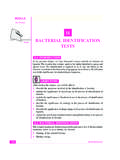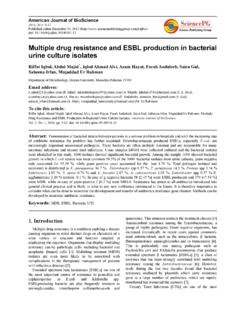Transcription of Description and importance of the disease - Home: …
1 Pullorum disease of chickens is a bacterial infection caused by Salmonella enterica subspecies enterica serovar Gallinarum biovar Pullorum (Salmonella Pullorum)1. At this time the serovar is referred to as Gallinarum in some parts of the world and Pullorum in others; in this chapter the serovar will be referred to as Gallinarum or Pullorum according to the biovar under discussion as this is more meaningful from a clinical and epidemiological perspective. In its acute form, Pullorum disease is almost exclusively a septicaemic disease of young chickens. However, the organism may also be associated with disease in turkey poults and may be carried subclinically or lead to reduced egg production and hatchability plus a range of atypical signs in older birds.
2 Ovarian transmission is a major route by which the organism can spread. Game birds and backyard poultry flocks may act as reservoirs of infection, and wild birds may act as vectors for the organism and as such are important in the epidemiology of the disease . Fowl typhoid in chickens and turkeys is caused by S. Gallinarum biovar Gallinarum and is more often observed in the later growing period and in mature stock. disease is often characterised by rapid spread with high morbidity and acute or subacute mortality. Red mites may be involved in the transmission of disease and persistence in poultry houses Clinical signs in chicks and poults include anorexia, diarrhoea, dehydration, weakness and death.
3 In mature birds Pullorum disease is less severe but decreased egg production, poor hatchability and some increased mortality may occur. Fowl typhoid is a more acute septicaemic condition which mainly affects mature birds and may be particularly severe in commercial laying flocks. Identification of the agent: Samples should not be taken from birds or eggs that have recently been treated with antimicrobial drugs. Swabs or aseptically collected samples from infected tissues, or intestinal and cloacal contents should be used for diagnostic testing. Other materials that may be sampled include eggs, embryos, faecal droppings and hatcher debris, especially fluff, dust and broken eggshells and chick box linings.
4 Samples of tissues such as caecal tonsils and spleen from infected birds are preferable to faecal and environmental samples. Tissue samples should be inoculated into non-selective and selective enrichment broths and on selective agar medium, such as brilliant green agar, as soon as possible after collection. In case of delay, samples should be stored at 4 C. Typical colonies can be identified by serological and biochemical tests. Molecular approaches can also be used to identify and differentiate S. Gallinarum and S. Pullorum. Final serological confirmation of suspect isolates can normally only be completed in a Salmonella Reference Typing Laboratory.
5 Serological tests: These are satisfactory for identifying the presence and estimating the prevalence of infection within a flock. The test used in the field is the rapid whole blood plate agglutination test. This test is unreliable in turkeys and ducks as many uninfected birds may give positive reactions. In the laboratory a serum agglutination test is used, either as a rapid plate test or as a tube test. These can be applied as macro- or microagglutination tests though the latter may be more likely to give false-positive results with turkey sera. Any positive reactors should be confirmed as being infected by culture at post-mortem examination.
6 Enzyme-linked immunosorbent assays have been reported but no commercial test is available. The use of vaccines to control S. Enteritidis or S. Gallinarum infections in chickens may cause problems in the interpretation of serological results. 1 See the note in Chapter Salmonellosis for the principles followed concerning the nomenclature of Salmonella. Requirements for vaccines: Live and inactivated vaccines are available for fowl typhoid in some countries. The most commonly used vaccine is a commercial live vaccine derived from the stable rough strain of S. Gallinarum known as 9R . Fowl typhoid and pullorum disease , caused by Salmonella enterica subspecies enterica serovars Gallinarum biovars Gallinarum and Pullorum, respectively, are widely distributed throughout the world but they have been eradicated from commercial poultry in many developed countries of Western Europe, the United States of America (USA), Canada, Australia and Japan.
7 In the United States and the United Kingdom the serovar is referred to as Pullorum (Hitchner, 2004), even though the strains are now considered to be the same serovar that is derived from by gene deletion events (Thomson et al., 2008); in this chapter the terms serovar Gallinarum or Pullorum will be used, as this more usefully distinguishes the two biovars that cause clearly distinct clinical syndromes and are therefore epidemiologically different. S. Gallinarum has recently recurred in some European countries (Ivanics et al., 2008). Salmonella Pullorum remains as a constant reservoir in wild and game birds. Salmonellosis caused by Salmonella bongori or subspecies of Salmonella enterica is covered in Chapter Salmonellosis.
8 Clinical signs of fowl typhoid are typical of a septicaemic condition in poultry and include increased mortality and poor quality in chicks hatched from infected eggs. Older birds show signs of anaemia, depression, laboured breathing and diarrhoea causing adherence of faeces to the vent. The highest mortality in pullorum disease occurs in birds of 2 3 weeks of age. In older birds disease may be mild or inapparent. In breeding and laying flocks susceptibility is increased at the point of lay (Wigley et al., 2005), but reduced egg production and hatchability may be the only signs of Trans-ovarian infection resulting in infection of the egg and hatched chicks or poults is one of the most important transmission routes for both diseases.
9 Post-mortem signs of pullorum disease in newly hatched chicks are those of peritonitis with generalised congestion of tissues and an inflamed unabsorbed yolk sac. Longer standing infections commonly lead to typhlitis with development of necrotic caecal casts and small necrotic foci in the liver, lungs and other viscera. Small lesions in the liver and spleen of Pullorum-infected birds may show a white spot appearance that is not seen with Gallinarum; however, this lesion is not pathognomic. These Salmonella are very poor at colonisation and survival in the gastrointestinal tract is often indicative of later stages of clinical disease . Adult birds may develop misshapen or shrunken ovaries with follicles attached by pedunculated fibrous stalks.
10 Variant strains of S. Pullorum do not normally cause clinical disease or may result in mild, nonspecific signs but may lead to seroconversion. In fowl typhoid, as well as generalised signs of septicaemia, the liver is usually enlarged, dark and friable with a distinctive coppery bronze sheen that may only develop after exposure to air. The bone marrow is also often dark brown. Although clinical signs and post-mortem findings of pullorum disease and fowl typhoid may be highly suggestive of the conditions, they are not sufficiently distinct from other causes of septicaemia to be pathognomic. It is therefore necessary to confirm disease by isolation of the organisms.














